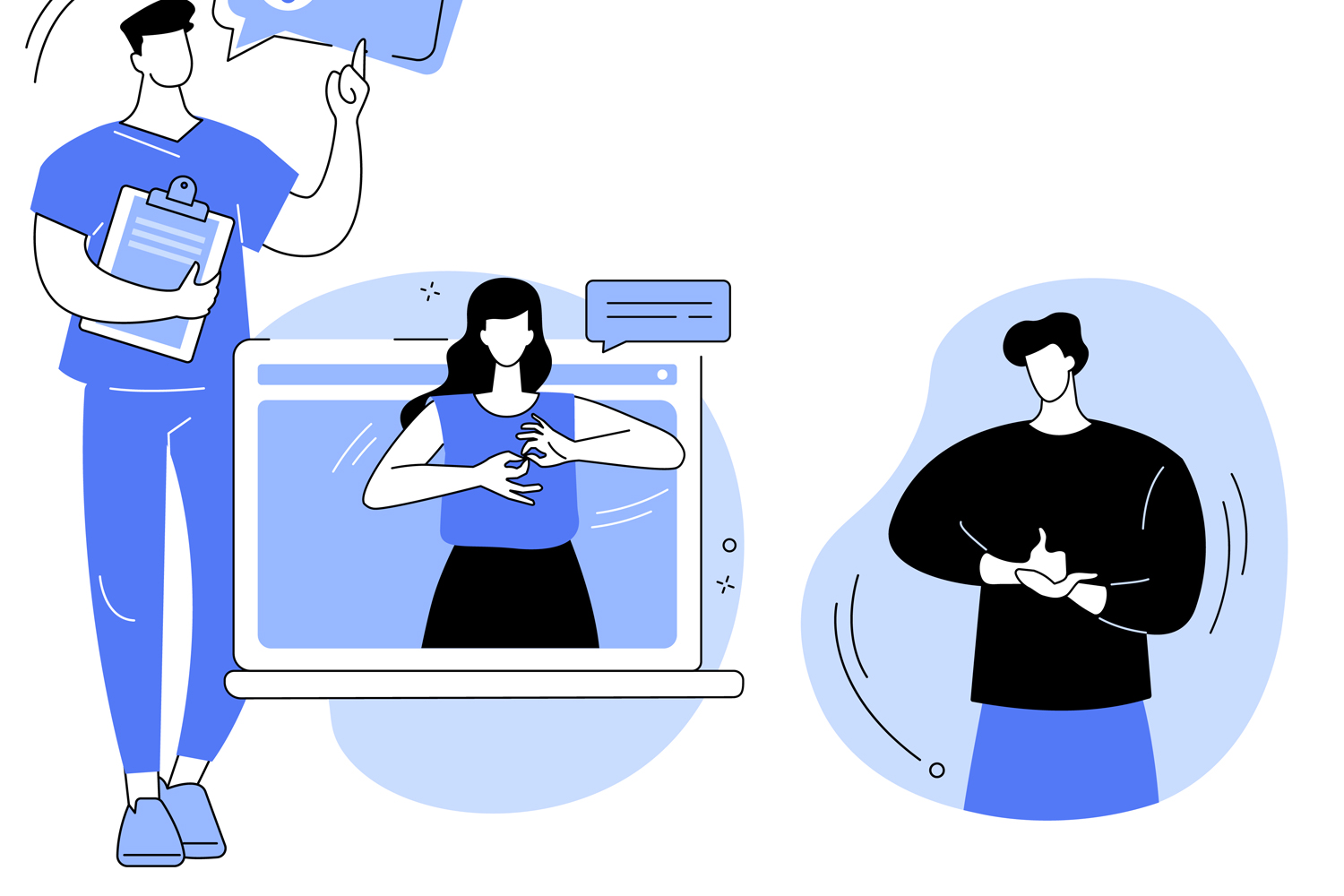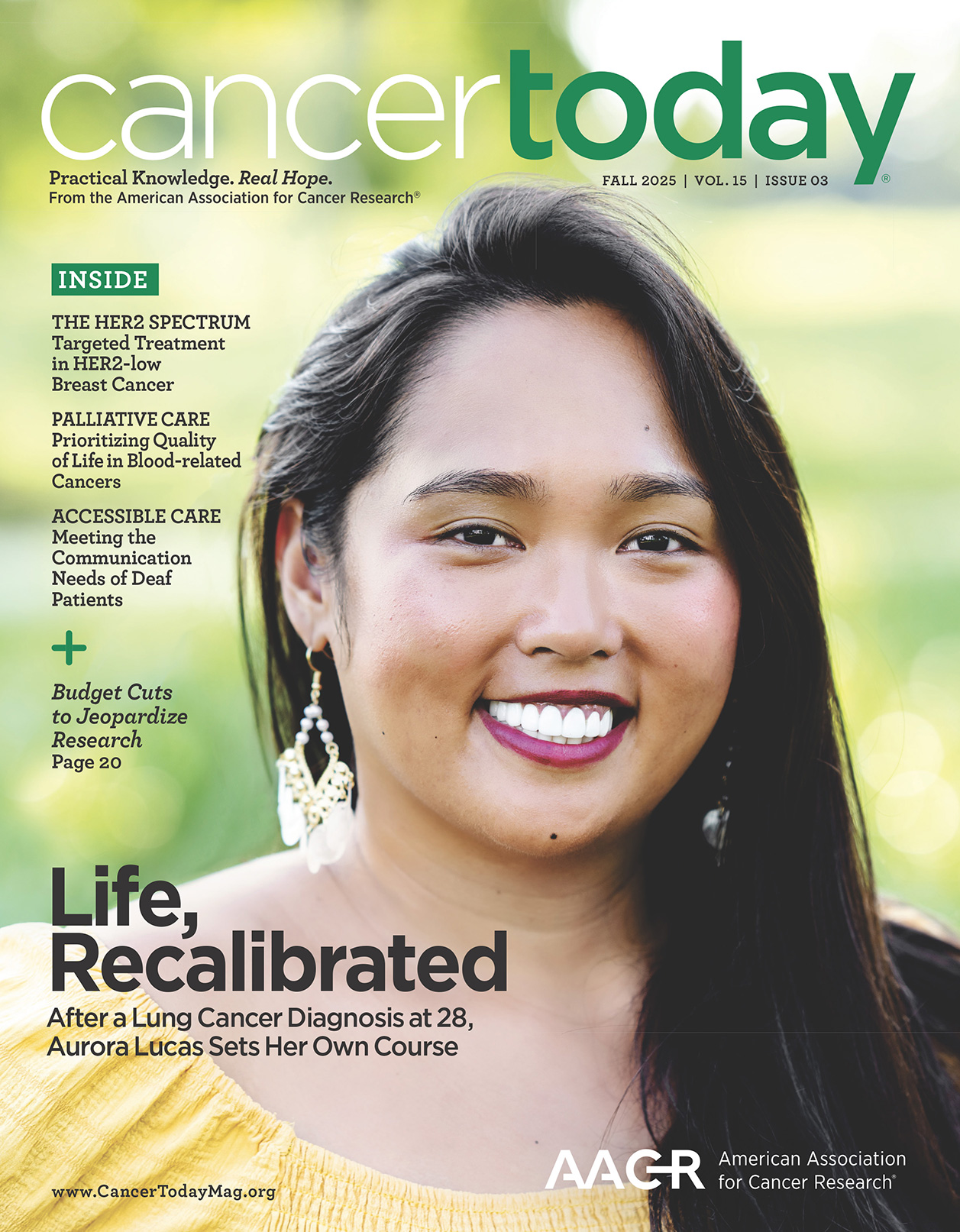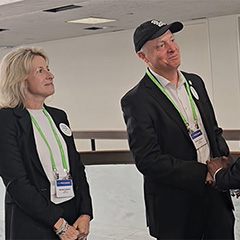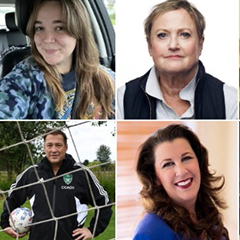DARLENE ZANGARA HAD STEPPED OUT from her stepfather’s hospital room to get some food and returned to learn shocking news. Her stepfather, who was in treatment for stage IV pancreatic cancer, had just been told he no longer had cancer. Zangara knew something was off.
Zangara is deaf, as was her stepfather.
She and her husband were visiting her stepfather while he was hospitalized in 2001. While they were out of the room, a doctor stopped by to share the results of a scan. He did not bring an American Sign Language (ASL) interpreter but attempted to communicate the findings in writing.
“My stepfather was not fluent in English,” Zangara says in an interview with Cancer Today through an ASL interpreter. “His primary language was American Sign Language, so writing back and forth, he saw good news: ‘no cancer.’”
Zangara found the doctor, who explained the results again. The test had found no sign of cancer in his stomach or intestine specifically, but her stepfather still had stage IV cancer. Her stepfather was devastated. “I have never seen a grown man cry as much as he did,” Zangara says.
People who are deaf, deafblind or hard of hearing—sometimes shortened to DDBHH—often face obstacles in hospital communication, starting with the limited availability of interpretation services. In-person interpreters may not be readily available, and patients may need to do the administrative work of reserving and scheduling ASL interpretation for their appointments.
In addition, interpretation services may not meet an individual’s needs, particularly in relaying complex health care information, says Emmanuel Perrodin-Njoku, a predoctoral research associate with the Center for Deaf Health Excellence at Gallaudet University in Washington, D.C. Agencies that provide interpretation services don’t always have enough staff with the training or experience to interpret unfamiliar terms and concepts related to a patient’s condition or treatment.
Zangara, who is 61 now and lives in St. Paul, Minnesota, received her own diagnosis of stage I pancreatic cancer in 2019. She says some interpreters booked through the medical center were visibly overwhelmed and struggled with the medical content and language during her appointments.
“Sometimes the doctors would elaborate, but the interpreters weren’t able to follow. So they were literally signing word for word without giving me any context or concepts, which is what you should be interpreting for,” Zangara says.
A Little Less Conversation
ASL is a distinct language from English, with a unique grammar and different rules for forming words and sentences. ASL interpreting is more than just word-for-word translation from English, which is why many people prefer it over text-based communication. ASL interpreters can convey tone and gesture, capturing many of the ways we communicate when speaking beyond the words themselves.
“I think being able to have interpreters present is the equivalent of being able to chat with your doctors openly,” says Alison Aubrecht, 46, of Arizona, who was diagnosed with multiple myeloma in 2022. Through an online text chat, Aubrecht, who is deaf, says communicating by text slows things down, interrupts the natural cadence of conversation and can feel laborious, leading both patients and doctors to share less information.
“When interpreters are present, a lot of that goes away (provided doctors are comfortable with interpreters, [which is] not always the case). The flow of conversation is easier,” Aubrecht says. Many deaf people are more fluent in ASL than they are in written English. “To have to write back and forth with doctors—the chances of misunderstanding or not being able to ask the right questions increase exponentially,” she says.
Deaf patients often face obstacles to accessing health care before they get to an exam room, providers can take steps to better accommodate their needs.
People who are deaf or hard of hearing will often use American Sign Language (ASL) interpreters to communicate with doctors in medical settings. Here are some additional steps that health care teams can take to ensure deaf people receive quality care.
Signs and indicators. Visual cues, such as a waiting room screen that displays a name or number when it is time for the patient to come back to see their physician, along with signs that include directional arrows, can guide patients smoothly through office visits.
Visual aids. Health care providers can use anatomic models and graphics or even draw freehand to illustrate key points that explain a patient’s diagnosis and treatment.
Seamless scheduling. Health care providers can use technology to offer a streamlined scheduling system that allows people who are deaf to easily request ASL interpreters.
Patient preferences. Health care providers should work to meet the individual communication preferences of all patients, including those who are deaf. By taking steps such as working with interpreters who are comfortable conveying complex medical information and asking patients what accommodations best meet their needs, providers can help make patients feel more comfortable in discussions about their health.
A DDBHH patient’s experience begins before they ever step foot in a health care facility. Erika Bergeron, research manager at the Center for Deaf Health Excellence, says through an interpreter that in some health systems, the online portals for setting up appointments lack an option to request an in-person ASL interpreter; they only list an option for an interpreter to participate through a video call, called video remote interpreting or VRI.
If the cancer center uses VRI or doesn’t have an interpreter ready on arrival, Aubrecht says navigating the initial interactions can be awkward for her and add to her stress. She might have to fumble her way through conversations at the reception desk, largely through writing. Because she won’t hear her name being called, she must watch closely and try to read their lips, which can be especially challenging when it comes to names. Interpretation services offered through VRI generally begin when the doctor arrives, but problems with the video connections or software can sometime interfere. These barriers can cause Aubrecht to delay or cut short her exchanges at the cancer center.
“One of the things I find with cancer is there is often a sense of [feeling overwhelmed], and that can really impact our access to the part of the brain where we problem solve, create, memorize,” Aubrecht says. “I struggle to self-advocate within that context. It requires more energy—mentally and emotionally—to do that. And I find myself avoiding the whole thing altogether, even at the expense of my health.”
Research from the Center for Deaf Health Excellence has looked into disparities in care for DDBHH patients and the importance of accommodating their communication needs. A 2018 study published in Patient Education and Counseling found that people who are deaf and currently smoking or had formerly smoked were more likely to ask about lung cancer screening if they could communicate using ASL at appointments, either directly with their health care provider or through an interpreter, compared with those who reported not using ASL at appointments. And at the American Association for Cancer Research (AACR) Annual Meeting 2024 in San Diego, the center presented data from the National Health Interview Survey that found just 43.7% of DDBHH adults reported being up to date with colorectal cancer screening, compared with 58.7% of the general population. (The AACR publishes Cancer Today.)
Lost in Interpretation
ASL interpretation is an important option to have, but it’s not the only means of communication for DDBHH people. “I think it is very important, but the DDBHH population is very heterogeneous in their linguistic and communication preferences,” says Colin Hill, a radiation oncologist at NYU Langone Health’s Perlmutter Cancer Center in New York City, via email. Hill is deaf and has researched cancer care accessibility for people who are deaf.
“While I prefer to communicate in ASL, a lot of DDBHH people are not necessarily native users of ASL, and their preferences are largely dictated by their upbringing and educational background,” Hill says.
Some patients, for example, may request a deaf interpreter in addition to an ASL interpreter, Perrodin-Njoku says. A deaf interpreter is someone who learned ASL as their primary language and can communicate in ASL at a level that is less influenced by English. An interpreter who can hear will translate the speech into ASL, and the deaf interpreter will reinterpret it in a way that is more familiar to people who learned ASL as their primary language. This may be more comfortable for the patient and can help them as they try to understand the complex information.
For people who are both deaf and blind, there is Protactile interpretation, a distinct language in which the patient is in physical contact with an interpreter as they use gestures and touch to communicate. Protactile interpretation offers more information than just the words spoken by a health care provider, according to Bergeron, including context about where other people are and the space and actions happening around them.
There are many ways to engage with people who require communications accommodations. Zangara found it helpful when her surgeon walked her through the Whipple procedure, a surgery she would undergo to remove parts of the pancreas and stomach along with other nearby tissue, by using a notepad to draw what the procedure would look like. “That was my first real understanding of the location of the tumor, how everything was connected in my body and why it was so important,” she says.
Aubrecht suggests practical elements such as offering patients text messages for communications outside of appointments and using a visual cue when calling people in from the waiting room—for example, “getting a number and having that number pop up on the screen like at the DMV,” Aubrecht says.
“It’s helpful to have providers engaging with patients to identify what is their preferred means of communication. So maybe ask them, ‘Do you like having visual aids that I use?’ ‘Would you like to have a deaf interpreter in place?’” Perrodin-Njoku says.
“As we talk about interventions here, it doesn’t only benefit the deaf, deafblind and hard of hearing community,” Perrodin-Njoku says. “These would also benefit hearing individuals to better understand the information through having these resources.”
The challenges of communication sometimes go beyond the doctor and patient. Interpretation policies are often set by the health system, reimbursement for services may depend on insurance coverage, and states may have different requirements for what services must be available.
As things stand, DDBHH individuals may have to push both for their communication needs and their health care generally. Zangara, who has been through cancer treatment as both a patient and a caregiver, suggests patients designate a friend or family member as an advocate—someone who is there to watch for their needs and ask for more information or summon help when needed. Zangara had multiple family members who accompanied her during care but says her sister was particularly good in that respect. “She was able to step out of that emotional state, to see more neutrally, and I think that was really helpful,” Zangara says. And while she appreciated everyone who was there to care for her, when she was in pain or dealing with upsetting news, what she valued most was having someone in her corner to ensure her needs were met.
Cancer Today magazine is free to cancer patients, survivors and caregivers who live in the U.S. Subscribe here to receive four issues per year.





